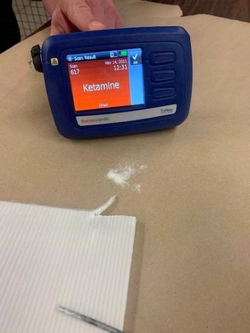Will Ketamine Be the Next Major Drug Trend?
With a 349% increase in seizures of ketamine just in the last five years, public health officials and law enforcement officers are wondering if ketamine addiction will be the next major drug trend.

Though legal for use in veterinary practices and some hospital settings, ketamine should not be used recreationally or self-medicated. Unfortunately, law enforcement departments are increasingly seizing ketamine in drug busts. Further, much of the ketamine being seized is not pharmaceutical grade. Much of it is in powder form, meaning other drugs could also be mixed in.
What the Latest Findings Show

Image courtesy of cbp.gov
A paper titled “Trends in Illicit Ketamine Seizures in the US From 2017 to 2022” was published in the Journal of the American Medical Association. According to the research, the number of ketamine seizures and drug busts by law enforcement has soared by 349% since 2017. Regarding the volume of drugs seized, 127 pounds of ketamine were seized in 2017, whereas about 1,550 pounds were seized in 2022, a 1,100% increase.1
The researchers involved in the study ascribed particular concern to the fact that much of the seized ketamine is in powder form, not pharmaceutical form, meaning it was almost certainly made in clandestine drug labs and not by pharmaceutical companies. (Or even if pharma companies made it, it was ground into powder and mixed with other drugs, chemicals, additives, or fillers).
That puts users at even greater risk, as they cannot know what they’re taking. “Unlike illegal ketamine years ago, most illegally obtained ketamine today is not pharmaceutical grade and is sold in powder form, which may increase the risk that it contains other drugs such as fentanyl,” said study co-author Joseph Palamar, a researcher in the Center for Drug Use and HIV/HCV Research at NYU School of Global Public Health. While ketamine by itself can cause overdoses, if the ketamine has fentanyl in it, an overdose is much more likely to occur.2
“Unlike illegal ketamine years ago, most illegally obtained ketamine today is not pharmaceutical grade and is sold in powder form, which may increase the risk that it contains other drugs such as fentanyl,”
The researchers were especially concerned about illicit ketamine. According to their findings, “Loosened prescribing restrictions during the COVID-19 pandemic may have led to an industry of pop-up clinics prescribing ketamine online and off-label.” That may have spiked local interest in ketamine, which could explain why the drug has more than tripled in popularity in a relatively short time.
Every time a new drug enters the market or an old drug becomes popular again; clandestine drug operations will try to find a way to replicate the drug in underground labs. When such organizations produce their own brand of ketamine, users and addicts cannot know if fentanyl is also used in making the drug.
Fentanyl is a powerful opioid, more than ten times as potent as heroin and between 50 and 100 times more potent than morphine. According to the Centers for Disease Control and Prevention, fentanyl was thought to be involved in nearly 70% of all drug-related deaths that occurred in 2021.3
What is Ketamine, Exactly?

Described as a “dissociative anesthetic with some hallucinogenic effects,” ketamine is prescribed in human and veterinary medicine to produce varying degrees of anesthesia. It can be used in high doses to anesthetize a patient for surgery. In low doses, it can be prescribed for patients to treat chronic pain and depression.4
When taken in low doses, ketamine can distort the perception of sight and sound and make the user feel disconnected and not in control of their body or mind. It makes people feel detached from their environment, hence why it is referred to as a dissociative drug.
When used medicinally, ketamine can bring about a state of calm, relaxed sedation. In higher doses, it causes immobility, relief from pain, and amnesia. When used recreationally, users take it in high doses to cause hallucinations. It has also been used to facilitate sexual assault.
The Short and Long-Term Effects of Experimenting with a Veterinary Drug

Common short-term side effects from using ketamine include:
- Nausea
- Agitation
- Depression
- Cognitive difficulties
- Trouble solving problems
- Unconsciousness and amnesia
- Involuntarily rapid eye movement
- Dilated pupils and uncontrolled salivation
- Tear secretions and stiffening of the muscles
One of the long-term effects of ketamine use is a condition called Hallucinogen Persisting Perception Disorder (HPPD). This condition has been reported in users even up to several weeks after their last ketamine use. Such a condition may include prolonged visual disturbances in which the individual cannot discern reality from a hallucination. What is especially concerning about these experiences is that they are unpredictable and may occur days or weeks after one has last used the drug. Other long-term effects include addiction, overdose, and death.
The Need for Treatment for Those Addicted
People need to be aware of what ketamine is, and they must not get fooled into thinking that it is safe to self-medicate or experiment with it recreationally just because the drug is used in a medicinal or veterinary setting. If you know someone who has begun experimenting with ketamine but cannot stop using it, please help them find and enter a qualified drug and alcohol addiction treatment program. Please do not wait until it is too late and they overdose.
Sources Cited:
-
JAMA. “Trends in Illicit Ketamine Seizures in the US From 2017 to 2022.” Journal of the American Medical Association, 2023. jamanetwork.com ↩︎
-
USNews. “Illicit Use of Ketamine Keeps Rising in U.S.” U.S. News, 2023. usnews.com ↩︎
-
CDC. “Illicitly Manufactured Fentanyl–Involved Overdose Deaths with Detected Xylazine — United States, January 2019–June 2022.” U.S. News, 2023. cdc.gov ↩︎
-
DEA. “Ketamine.” Drug Enforcement Administration, 2023. dea.gov ↩︎







 ®
®